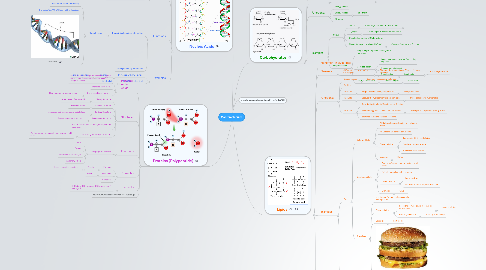
1. Proteins (Polypeptide)
1.1. Monomer- Amino Acids
1.1.1. All look the same except for one variable group that changes the properties. In this case "R" being the variable.
1.1.2. There are 20 of them.
1.1.3. Get chained into a polymer
1.1.3.1. Held together by peptide bonds
1.2. Stuctures:
1.2.1. Primary Structure
1.2.1.1. A sequence of amino acids
1.2.2. Second Structure
1.2.2.1. Chains coil or fold
1.2.3. Teritiary Structure
1.2.3.1. Atrraction between alpha and beta helixes
1.2.4. Quaternary Structure
1.2.4.1. One or more chains bonded
1.2.5. The structures must be the right shape to do their jobs.
1.2.6. Denaturing (unfolding) can occur.
1.2.6.1. Can be caused by change in temperature or pH levels.
1.3. Functions:
1.3.1. Multipurpose molecule
1.3.1.1. Build
1.3.1.2. Protect
1.3.1.3. Send chemical messages
1.3.1.4. And many others
1.4. Examples:
1.4.1. Enzymes
1.4.1.1. Pepsin
1.4.1.1.1. Helps in chemical reactions
1.4.2. Hormones
1.4.2.1. Insulin
1.4.3. Movement
1.5. Elements:
1.5.1. C (Carbon), H (Hydrogen), O (Oxygen), and N (Nitrogen)
1.6. http://www.youtube.com/watch?v=5oBdItzs7jE
2. Nucleic Acids
2.1. Monomer- Nucelotides
2.1.1. 3 Parts:
2.1.1.1. Base
2.1.1.2. Pentose sugar
2.1.1.2.1. 5 Carbons
2.1.1.2.2. Ribose in RNA
2.1.1.2.3. Deoxyribose in DNA
2.1.1.3. Phosphate Group
2.2. Elements:
2.2.1. C (Carbon), H (Hydrogen), O (Oxygen), N (Nitrogen), and P (Phosphorus)
2.3. Functions:
2.3.1. Transmitting hereditary information
2.3.1.1. Through genes
2.3.1.1.1. Passed from parent to offspring
2.3.1.1.2. The codes (Ex. ACTGGTCATTG) build proteins
2.3.1.1.3. New node
2.3.2. Storing hereditary information
2.4. Examples:
2.4.1. DNA (Deoxyribolnuleic Acid)
2.4.1.1. Two chains
2.4.1.1.1. Form a double helix
2.4.2. RNA (Ribonucleic Acid)
2.4.2.1. Single chain
3. Carbohydrates
3.1. Monomer- Monosaccharide
3.2. Elements:
3.2.1. C (Carbon), H (Hydrogen), and O (Oxygen)
3.2.1.1. In a 1:2:1 ratio
3.3. Functions:
3.3.1. Energy source
3.3.2. Energy storage
3.3.2.1. Short term
3.3.3. Structure
3.4. Example:
3.4.1. Sugars
3.4.1.1. Starch
3.4.1.1.1. Stores sugars in plants' root structures
3.4.1.2. Glycogen
3.4.1.2.1. Stores sugars in animals' muscle tissue
3.4.1.3. Classified by number of Carbon atoms
3.4.1.4. Names for sugars usually end in "ose"
3.4.1.4.1. Glucose, Fructose, and Sucrose
3.4.2. Polysaccharides
3.4.2.1. Long strings of repeated carbohydrate monomers
3.4.2.2. Cellulose (Fiber)
3.4.2.2.1. Keeps the excretory system functioning regularly
3.4.2.2.2. Humans cannot digest it
3.4.2.2.3. Found in plants
3.4.2.3. Chitin (Exoskeleton)
3.4.2.3.1. Found in fungus
4. Lipids
4.1. Monomer- Triglycerides
4.2. Elements:
4.2.1. C (Carbon), H (Hydrogen), and O (Oxygen)
4.2.1.1. Disproportionate number of C's and H's (more of them)
4.2.1.1.1. This is a hydrocarbon
4.3. Functions:
4.3.1. Energy storage
4.3.1.1. Long term because it weighs less
4.3.2. Cushion
4.3.3. Insulation
4.3.3.1. Helps to maintain body temperature
4.3.3.1.1. Example- blubber
4.3.4. Insoluble
4.3.4.1. Because the hydrocarbon tails are non-polar
4.3.4.1.1. This is called being hydrophobic
4.3.5. Structure
4.3.5.1. Dehydration Synthesis/ Condensation Reaction
4.3.5.2. Needs energy which comes from fatty acids
4.3.5.2.1. "Don't put your lipids on my fatty acids!"
4.3.5.3. Enzymes cause the chemical reactions
4.4. Examples:
4.4.1. Fats
4.4.1.1. Saturated Fats
4.4.1.1.1. All Carbon atoms are bonded to Hydrogen atoms
4.4.1.1.2. No Carbons are bonded to Carbons
4.4.1.1.3. Characteristics:
4.4.1.1.4. Example:
4.4.1.2. Unsaturated Fats
4.4.1.2.1. Carbon to Carbon bonds in the fatty acid chains
4.4.1.2.2. Not fully saturated with Hydrogen
4.4.1.2.3. Characteristics:
4.4.1.2.4. Example:
4.4.1.3. Trans Fats
4.4.1.3.1. Unsaturated fat that has been partially hydrogenated
4.4.1.3.2. Characteristics:
4.4.1.3.3. Example:
4.4.1.3.4. New node
4.4.2. Oils
4.4.3. Waxes
4.4.4. Phospholipids
4.4.5. Steroids
